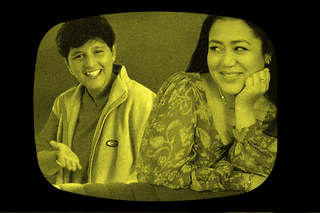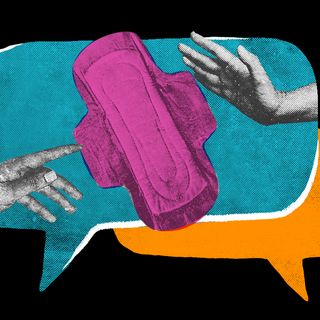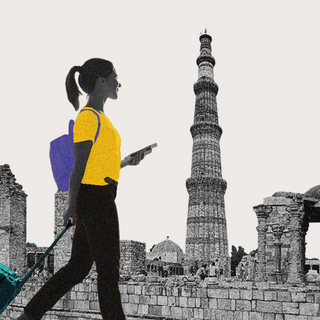
Why People Hate Remakes of Songs They Love
When remakes alter a song that’s special to us, it can feel like they’re trying to manipulate our memories.

Neha Kakkar’s recent release, O Sajna, is many things: heavily auto-tuned, and lacking in both originality and the quintessential innocent vibe of the 90s. It is also highly controversial at this moment in time, as many find this remake of Falguni Pathak’s 1999 hit, Maine Payal Hai Chhankai particularly grating on their memories. With a current like-to-dislike ratio of 530,000 to one million, the song has been panned widely. Maine Payal Hai Chhankai is a song that thousands of Indians associate with their first teenage crushes; Kakkar’s version, then, felt like an unsettling adulteration of this nostalgia — with many accusing the song of “ruining” their childhood memories.
This isn’t the first time a remake has angered audiences; Dheere Dheere (1990 and 2015), Humma Humma (1998 and 2017), and Dus Bahaane (2005 and 2020) are other tunes that traveled through time only to be changed for the worse, according to audiences who liberally sprinkled words like “torture” and “massacre” to make their disdain for the remakes known. What is it about remaking and remixing nostalgic songs that collectively upset people so much — is it just a knee-jerk reaction set off by herd mentality, or are there deeper, more neuropsychological reasons behind it?
“[T]o have something that you feel very fondly towards, and to see it be manipulated or changed in often-cynically-motivated ways is very irksome,” Dean Burnett, a neuroscientist, had noted, explaining people’s anger at remakes of their favorite childhood movies. This applies to wistful melodies too.
The music we hear as children, as adolescents, or even during early adulthood, can have a lasting impact on our memory due to a psychological phenomenon called the “reminiscence bump.” Between the ages of 10 and 30, research suggests, “[W]e lay down memories and store information that will define who we are for the rest of our lives — the crystallization of the self in memory.”
By threatening to obscure precisely that, remakes can feel like a personal affront. “[T]he prominence in our memories of our childhood entertainment may mean they are a disproportionately large aspect of our identity. So, any attempt at updating or chang[ing] could, in a weird way, be perceived as an attack on our identity. And people tend to react very negatively to such things,” Burnett added.
Music can trigger emotions, too — matching the ones we felt when we first heard the original renditions. Every song we grew up loving, then, can assume the form of a “key to that box” of memories in the brain. “There is evidence that structural elements of music get physically tied to our autobiographical memories. Musical reminiscence bump is so powerful because we attach music to particularly emotional times,” Catherine Loveday, a cognitive neuropsychologist at the University of Westminster, told BBC.
Related on The Swaddle:
How Nostalgia Can Act as a Pain‑Reliever
The more time that has lapsed between an original and a remake, the more likely it is for the remake to fundamentally change in its construction — it tailors its chords, rhythms, and melodies to cater to the tastes of newer generations. People’s resentment against remakes of songs they heard as teenagers, then, is also in line with the commonly observed phenomenon of older people disliking newer songs — just like one’s parents or grandparents might accuse new-age composers of not making as amazing music as they grew up listening to. “By the time we’re in our early 20s, [our musical] tastes get locked into place pretty firmly,” Frank McAndrew, a social psychologist, explained in The Conversation. Distastefulness infused into a song we hold dear can, naturally, become a source of agitation.
As Saumya Kalia noted in The Swaddle, “Even instinctively, the song becomes a way to sustain the shared past people once had together… The music-evoked nostalgia is not only a way to remain tethered to the past or even escape the present, but a reminder that joy can always be found.” Their remakes, however, threaten to eclipse this joy; by presenting familiar tunes and lyrics in a new package, they inspire a sense of disconcertedness, rather than blissful comfort. As Kalia added, “This is nostalgia, tied to an unwavering sense of preservation.”
The uncertainty brought about by major changes in life can be unsettling, and nostalgia, more often than not, helps us endure this change. But when the nostalgia-inducing device itself is adulterated — through remakes like O Sajna — one is faced with the loss of the delicate sensory-emotional bridge that grants them access to happier, more innocent times from the past.
Granted, in theory, one has the option to simply not add the remade version to their playlists. But, practically, they can be almost impossible to avoid unless one is ready to arm themselves with noise-canceling earphones every time they step into a party — be it at a club or at a Navratri event.
However, there’s more at play here than nostalgia alone.
The territory of remakes is an ethical landmine. For starters, if a song is remade by a studio — or even an artist — with more money and clout, it’s possible for the original rendition to be buried in the alleys of the internet. Simply by promoting the remake better and wider, and employing better SEO and marketing tactics, one can make it difficult for people to ever learn that it’s a remake, and not an original. Many Bollywood viewers, to date, continue to be unaware that 2016’s Soch Na Sake (sung by Arijit Singh) is a Hindi remake of Soch (sung by Harrdy Sandhu), a hit Punjabi song from 2013.
But remakes don’t just risk pushing originals into oblivion. They can also cause people, who hear the remake first, to get so used to it that they begin finding the originals disconcerting. “I grew up thinking that the covers were the original songs oddly enough, so listening to the originals was a jarring experience,” a Reddit user commented.
Perhaps, on some level, this makes us uncomfortable, deep down. Knowing that the fruits of one’s labor could one day be assigned to another without the original creator having any legal recourse isn’t an easy prospect to come to terms with — especially in a world where social, political, and economic power remains concentrated in the hands of a select few.
Related on The Swaddle:
Calling the practice of remaking older songs “disgusting,” a composer anonymously wrote in 2018, “I… detest and despise the whole idea of remixing; it completely spoils the originality, blemishes the creativity, and totally contaminates the artistic integrity of the original track in the first place.”
That is, perhaps, why remakes often invite chagrin from the makers of their originals, as in Pathak’s case. When A.R. Rahman’s much-celebrated track, Masakali from 2009’s Delhi-6, was remade 11 years later as Masakali 2.0, fans weren’t the only ones outraged. Rahman, who has both an Oscar and a Grammy to his credit, expressed his indignation online by sharing the original, with a caption saying: “No short cuts, properly commissioned, sleepless nights, writes and re-writes. Over 200 musicians, 365 days of creative brainstorming with the aim to produce music that can last generations. A team of a [d]irector, a [c]omposer and a [l]yricist supported by actors, dance directors and a relentless film crew.” Watching artists they grew up loving being disappointed thus, can further prompt people to despise the fresh iterations of songs they grew up with.
Moreover, when it comes to remaking Pathak’s music videos– like Maine Payal Hai Chhankai and Yaad Piya Ki Aane Lagi — there is additional harm. In an era when India almost entirely lacked queer representation in pop culture, it is speculated that Pathak’s indie releases were peppered with small, subtle “hints of queerness.” Irrespective of whether the queerness in Pathak’s videos was intentional — although a vast majority of interpretations suggest that they indeed were — they were, perhaps, instrumental (pun intended) in an entire generation of queer individuals coming to terms with their identities.
“With her floppy boy-cut, boxy jackets, and virtuous high pitch, Falguni Pathak was the queer icon we didn’t know we needed. And if her personal style was my first encounter with androgyny, her music videos were my initiation into non-normative sexuality… Even though the male model[s] in [her] video[s] [often possess] all the essential 90s heartthrob qualities — such as a middle-parting, unsolicited advice, and two shirts — [they are] ultimately irrelevant,” Sharvari Sastry wrote in 2020. “[W]ith each of her offerings, Falguni Pathak gave us a vision of [a] world where it was okay — even fun — for women to love other women, to imagine a life with them, and, most importantly to my preteen self, to openly desire them.”
More than two decades later, the remakes blend with dozens of other inane music videos where women on screen are defined by the male gaze. Remaking Pathak’s songs, then, dilutes their melodious divergence from the binary that was championed by most other pieces of Indian media, at the time. In doing so, the remakes force us to confront the cultural erasure of the very pieces of art they’re attempting to make money off of.
Devrupa Rakshit is an Associate Editor at The Swaddle. She is a lawyer by education, a poet by accident, a painter by shaukh, and autistic by birth. You can find her on Instagram @devruparakshit.
Related


In Conversation: On the Official Who Dismissed a Girl’s Request for Free Sanitary Pads
